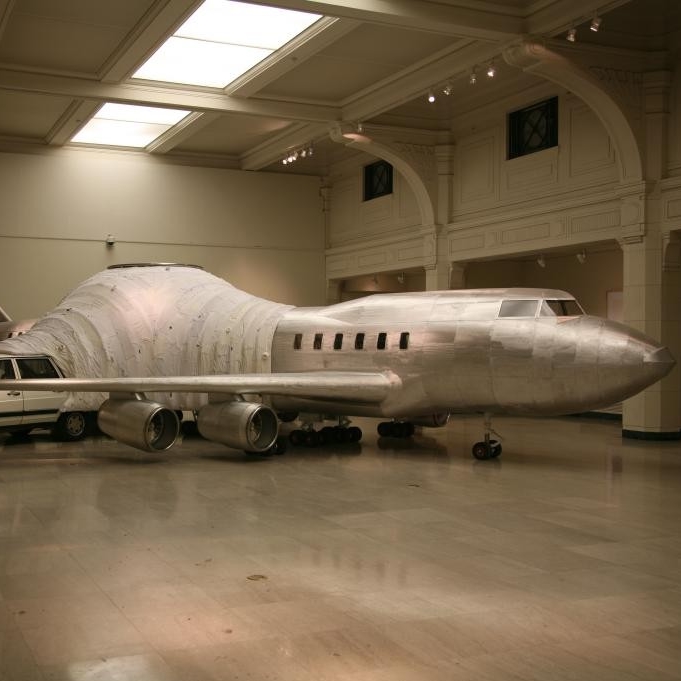
Hunsand Center for Contemporary Art (Shijiazhuang) announces its inaugural exhibition, “Being A Nomad: Liu Yazhou Solo Exhibition.”The exhibition unfolds with Liu Yazhou’s Balance series completed between 2014-2015: the artist selects everyday objects and adopts the "balancing technique" common in today's short videos, arranging, placing, stacking, and shaping them into unconventional forms and maintaining a steady relationship with gravity; eventually, the video captures this process of relative stillness and their inevitable collapse at the end.

Liu Yazhou, Samsara No.8, 2014-2015, HD video, 3min16s, courtesy the artist and Hunsand Center for Contemporary Art (Shijiazhuang).
This piece demonstrates a state of relative criticality. For the vast majority of the video duration, the image remains still, with time passing and seemingly frozen as the objects remain stably balanced; even in the final moment of collapse, the artist intentionally eliminates sound, further confusing the boundary between stillness and movement. The sense of time wanders rather than manifests causality. But the static embeds a precariousness because of the unknown time of the collapse. Yet, the collapse itself is definite. They are both within and beyond our anticipations, which possess time and are built within it. It is like being a nomad, whose directions are indeterminate, while one commands the rhythm and speed. Thus, freedom leads to chance encounters that sustain a continuous existence.

Liu Yazhou, Floor-Wall No.2, 2016, Single-channel video recording, 10min15s, color, Sound, Variable Size, courtesy the artist and Hunsand Center for Contemporary Art (Shijiazhuang)
Such uncertainty within certainty or vice versa is also prevalent in Liu’s 2016 work Ground-Wall No. 2, which captures an electric fan swaying from side to side facing a cheap disposable tablecloth. The artist kept the tablecloth hanging on the wall flat by adjusting various fan speeds until the end of the video; when he pulls the power, the formless tension keeping the tablecloth in its place is removed, dissolving the temporary balance of these objects. In the same year, the artist's Trapezoid stabilizes such a balance in a critical state. Three sets of concrete bricks are stacked together in a jagged manner, with the top two sets supported by branches so that the hard and the soft leverage one another, eventually reaching a state of equilibrium. To some extent, both works are the inward or outward expansion of the Balance series.
 Liu Yazhou, Floor-Wall No.2, 2016, Single-channel video recording, 10min15s, color, Sound, Variable Size, courtesy the artist and Hunsand Center for Contemporary Art (Shijiazhuang)
Liu Yazhou, Floor-Wall No.2, 2016, Single-channel video recording, 10min15s, color, Sound, Variable Size, courtesy the artist and Hunsand Center for Contemporary Art (Shijiazhuang)
If we were to conceive the constant or stationary as a kind of movement, then the acceleration would transform a physical space with the precept of maintaining (physical) balance, similar to charged levitation before the start of a maglev train, or when a person is standing upright and walking. As a primary transportation device, the car has redefined the scope of people's freedom of movement. From 2020 onwards, Liu Yazhou experimented with various means of deconstructing a car revolving around its many technical components, during which he considered the extension and connotation beyond its functions. Horizon was a work drawn from his experiments. Although it is an interactive installation, it does not actively expect or seek out viewer participation. It stands in place; as the viewers approach it, its headlights switch to long-range, and once the viewer leaves, they change back to short-range. Although the installation claims to be interactive, it only switches between these two modes. In other words, it projects the light on the wall, only to amplify the inorganic switch and distance itself through the void. Like the Balance series, it exists while wandering, suggesting the ubiquity of "being a nomad" where one drifts with time or is just a nomad of time.
About the artist
Liu Yazhou was born in Shijiazhuang in 1990. He graduated from the Department of Sculpture, Central Academy of Fine Arts with a Master's degree in 2017, and from the Department of Sculpture, Sichuan Fine Arts Institute with a bachelor's degree in 2014. He now lives and works in Beijing. His personal projects include: Ten - Waste, Fingerprint Gallery, Beijing (2019); Monks and Artists, Mumu Art Museum, Beijing (2018); Liu Yazhou: Tracks, Yang Gallery, Beijing (2017) In Life, UCCA-Lab, Yinshanhu Art Museum, Suzhou (2021) Superstructure, Lion Language Gallery, Shanghai (2019) The Power of Folk, Beijing Minsheng Modern Art Museum, Beijing (2015), etc..
About Hunsand Center for Contemporary Art (Shijiazhuang)
Hunsand Center for Contemporary Art (Shijiazhuang) is a complex dedicated to presenting public programs, lectures, workshops, art merchandise, and catering in addition to exhibiting contemporary art. As an outpost to the Beijing location, the Center's mission is to integrate artistic and audible practices into geographical and humanistic dimensions, by which to provide contexts for experiencing and pursuing the differences and connections between the traditional and modern, local and international, on-site and territorial, personal and historical, and spiritual and physical, bringing the ideas of contemporary art into more people's lives.
About the exhibition
Opening: Saturday, March 5, 2022, at 4 pm
Dates: March 5, 2022- April 17, 2022
Venue: 2nd Floor, Wonder Mall, Yuhua West Road, Qiaoxi District, Shijiazhuang, Hebei, China
Tel: 0311-66600320
Courtesy Hunsand Center for Contemporary Art (Shijiazhuang), for further information please contact info@hunsand.com.




























